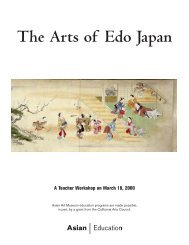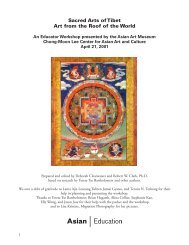Teacher Packet: Chinese Brushpainting (.pdf) - Asian Art Museum ...
Teacher Packet: Chinese Brushpainting (.pdf) - Asian Art Museum ...
Teacher Packet: Chinese Brushpainting (.pdf) - Asian Art Museum ...
Create successful ePaper yourself
Turn your PDF publications into a flip-book with our unique Google optimized e-Paper software.
Brushstrokes: Styles and Techniques of <strong>Chinese</strong> Painting<br />
and remote, with a leisurely and relaxed feeling." And the reclusive Ni Zan was know for his pale<br />
ink, dry brush, and sparse vegetation reflecting his remote and fastidious temperament. (A richer<br />
version of his style can be seen in slides 8 and 9.) Chao Meng fu, a leading painter and model<br />
calligrapher wrote:<br />
A rock should look like the "flying white,"<br />
and a tree like the "seal" stroke.<br />
In writing the bamboo leaves,<br />
one should first learn the pa-fen method.<br />
If a person understands this thoroughly,<br />
He will discover that calligraphy and<br />
painting have always been the same.<br />
In keeping with their literary bias, Yuan dynasty scholar-painters appropriated the use of paper, the<br />
horizontal handscroll, and the inclusion of long inscriptions on paintings. These inscriptions of old or<br />
new poems or comments by the artist added the flavor of scholarship and antiquity to the paintings,<br />
as did the formal four-character titles which were often added (see slide 1). Paper, which had long<br />
been used for written records and literary works, was more receptive to movement and pressure of the<br />
brush. The handscroll format allowed the creation of a long, unfolding composition which scholars<br />
could read like a book with like-minded friends. The handscroll was not a painting that would ever<br />
be hung or set out for decoration.<br />
During the Ming dynasty (1368-1644), the so-called professional or academic painters continued to<br />
develop parallel to, but were critically overshadowed by, the scholar-painters. Under the new emperor,<br />
the old Imperial Painting Academy was reestablished as the Zhe school in an attempt to revive the<br />
glory of China's past. At the beginning of this dynasty, the distinction between scholar and amateur<br />
painting was not hard and fast. <strong>Art</strong>ists like Qiu Ying and Lan Ying were able to cross from one style to<br />
the other and use their various talents depending on the occasion (see slides 4, 10, and 11).<br />
In the late Ming dynasty, however, the artist and critic Dong Qichang drew the firm line between<br />
professional and scholar painters, clearly favoring the latter. This had a lasting effect not only on the<br />
course of future painting but on the reputations of painters from the past as well. Dong Qichang<br />
divided <strong>Chinese</strong> painting into two categories: one group included literati painters of the Ming dynasty<br />
Wu school in southern China and the great masters of the Northern Song dynasty; Dong described<br />
the works of this category as spontaneous and intuitive. Dong called the other group the Northern<br />
School, which he characterized as being practiced, skillful, and belabored; included in this category<br />
were painters from the Zhe school. Dong’s firm stance on the status of painters embittered academic<br />
painters like Chen Hongshou (see slide 12), a talented painter trained first in the professional school<br />
but then not awarded the high degree of esteem that Dong granted to the less-trained scholar painters.<br />
Of Wang Wei, on the other hand, whom Dong considered to be the founder of the more respected<br />
Southern school, he wrote:<br />
It is commonly said that the painters before [Wang Wei] were not lacking in skill, but could not<br />
transmit the spirit of a landscape.... They had not yet reached that point. Mo Ch'i [Wang Wei]<br />
7 <strong>Asian</strong> <strong>Art</strong> <strong>Museum</strong>
















